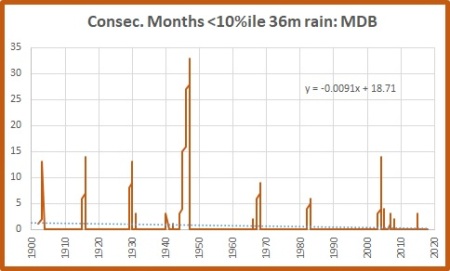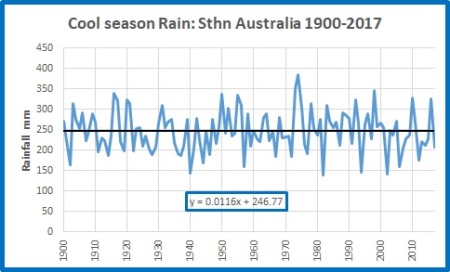Recently there was widespread media reporting of Queensland Emergency Services Minister Craig Crawford’s release of “a plan designed to help first responders get ready for future weather extremes.”
In the ABC Online report, these quotes from Mr Crawford are emphasised:
“There are plenty of people out there who are climate change sceptics… but the consensus is our fire seasons are getting hotter and longer and our flood and cyclone seasons are certainly getting stronger and more frequent.”
“If we’re going to have cyclones happening in parts of Queensland that they don’t normally happen right now it means that we’re going to have to expand all the areas where we have response training, capability and everything like that,” Mr Crawford said.
Cyclone seasons getting stronger and more frequent? Cyclones happening in parts of Queensland that they don’t normally happen right now? Time for a reality check.
The Bureau of Meteorology has a useful resource in its Southern Hemisphere Tropical Cyclone Data Portal which shows the tracks of all cyclones since the 1969-1970 season. By clicking on each track you find details of each. This is the 2017/18 season:
Fig. 1: Cyclones of the 2017/18 season

I have used it to look at all cyclones that have crossed the coast of Australia (and I have included TC Nancy which came very close and whose impact was strongly felt without actually crossing the coast.) I have counted the cyclones that crossed the coast in every month from October 1969 to now, allocating them to those parts of the northern coastline that they predominantly affected- the north-west, Northern Territory, Gulf of Carpentaria and northern Cape York, north-east Queensland, south-east Queensland (south of the Tropic of Capricorn), and New South Wales.
So here are some facts to annoy our Global Warming Enthusiast friends, and to demonstrate how ill-informed our Emergency Services Minister is.
Fig. 2: Total number of cyclones per season

There has been a decrease in the number of cyclones over the past 48 years, a rate of five less in 100 years. There has been little change in Western Australian cyclones:
Fig. 3: Total number of cyclones per season hitting North-West Australia

Whereas there has been a very noticeable decrease on the east coast (Queensland and NSW):
Fig. 4: Total number of cyclones per season hitting the east coast

which is well illustrated by this plot of cyclones crossing the Queensland coast south of the Tropic of Capricorn:
Fig. 5: Total number of cyclones per season hitting south-east Queensland

And these images of cyclone tracks are instructive:
Fig. 6: Cyclones of south-east Queensland 1969-1992

Fig. 7: Cyclones of south-east Queensland 1992-2018

Oswald, Marcia and Debbie crossed the coast north of the Tropic of Capricorn and were rain depressions by the time they reached the south-east.
The difference is obvious. No cyclone has crossed the coast south of Yeppoon since TC Fran in 1992. 26 years without a cyclone- people (and Mr Crawford) forget we had three in 1971. If we do get another one no doubt it will be blamed on climate change.
So what connection is there between temperature and cyclones?
Fig. 8: Australian tropical cyclones as a function of sea surface temperature

As temperatures go up, cyclones go down!
Fig. 9: Australian tropical cyclones as a function of Southern Oscillation Index

The SOI is an indicator of El Nino, La Nina, or neutral conditions. According to the BOM, consistently below -7 indicates El Nino, and above +7 indicates La Nina. It is obvious that there have been very few cyclones in seasons with El Nino conditions, with the vast majority in neutral or La Nina conditions, and higher SOI indicates greater likelihood of cyclones crossing the coast. This is not new, and the Bureau makes this clear.
Fig. 10: Tropical cyclones in La Nina years

Fig. 11: Tropical cyclones in El Nino years

Future trends:
The Bureau discusses future trends at length at http://www.bom.gov.au/cyclone/climatology/trends.shtml
but seems to base its conclusions entirely on climate models:
There remains uncertainty in the future change in tropical cyclone frequency (the number of tropical cyclones in a given period) projected by climate models, with a general tendency for models to project fewer tropical cyclones in the Australia region in the future climate and a greater proportion of the high intensity storms (stronger wind speeds and heavier rainfall).
This is the BOM plot of severe and non-severe cyclones, which includes all tropical cyclones from 90E to 160E south of the Equator, many of which remained well offshore.
Fig. 12: Severe and non-severe tropical cyclones

Is there any evidence for cyclones becoming stronger, if fewer? According to the BOM’s history of cyclones, no. This graph plots the number of cyclones rated as severe by the Bureau (<970 hPa central pressure at peak intensity- low pressure is a good predictor of wind speed). Interestingly, Marcia and Debbie are not listed as severe, but are described as severe in their reports, and definitely were, so I have included them in the tally.
Fig. 13: Severe land-falling tropical cyclones

And showing how the proportion of severe tropical cyclones as a percentage of all land-falling cyclones has changed:
Fig. 14: Proportion of land-falling tropical cyclones rated as severe

Tropical cyclones in the past 48 years have decreased in number and intensity, and the proportion of severe tropical cyclones has also decreased, although it is entirely likely that this situation could reverse due to natural variability.
The Government’s Response
The Queensland Government is concerned cyclones may strike further south than they currently do. They have records of cyclones going back 150 years. Many, many of them have affected south-east Queensland and NSW.
The worst natural disaster in recorded Australian history was in March 1899 when TC Mahina (the Bathurst Bay cyclone) killed 307 people.
Here are some other significant tropical cyclones recorded by the Bureau:
February 1893 a cyclone crossed near Yeppoon. This led to the Brisbane River floods.
January 1918. The Mackay cyclone, which caused many deaths. There was a large storm surge and a barometric pressure reading of 932.6 hPa in a private barometer, and less than 944.8 hPa at the Post Office as the flange on the instrument prevented the needle from going lower. Inland rainfall caused the highest recorded flood in the Fitzroy River.
March 1918. The Innisfail cyclone. The pressure dropped to 926 hPa at Mourilyan Sugar Mill. There was a large storm surge. Almost all buildings in the town were destroyed or badly damaged.
March 1949. A cyclone struck Rockhampton and Gladstone.
1967 TC Dinah affected southern Queensland and NSW. The pressure dropped to 944.8 hPa at Sandy Cape.
In Queensland, counting only those cyclones that have actually crossed the coast, not just approached, here is a list of tropical cyclones since 1970 (see Figure 6) that have struck south of the Tropic of Capricorn (Rockhampton or Yeppoon.)
February 1971 TC Dora
February 1972 TC Daisy
March 1972 TC Emily
January 1974 TC Wanda
March 1974 TC Zoe
February 1976 TC Beth
March 1976 TC Dawn
February 1981 TC Cliff
March 1992 TC Fran
TC Nancy (January 1990) came close but did not actually cross the coast.
TC Marcia in February 2015 crossed the coast near Shoalwater Bay before moving south over Rockhampton.
There is also an impressive list of cyclones which have caused deaths and wind, wave, and flooding damage in NSW. These include cyclones from 1892. Included are:
March 1939, TC crossed the coast at Cape Byron.
January 1950 The Sydney cyclone of 1950, when the pressure dropped to 988 hPa in Sydney.
February 1954, TC crossed the coast at Tweed Heads, where the pressure dropped to 973 hPa.
February 1957 TC crossed the coast south of Port Macquarie.
January 1967 TC Dinah caused a large storm surge in the Tweed River.
February 1967 TC Barbara crossed the coast near Lismore.
March 1974 TC Zoe crossed the coast just north of the border and travelled through northern NSW.
January 1990 TC Nancy did not cross the coast but passed about 50km east of Cape Byron.
The Reality
Contrary to Minister Crawford’s claim, and the media’s breathless and uncritical reporting, tropical cyclones in the past 48 years have decreased in number and intensity, and the proportion of severe tropical cyclones has also decreased. Predictions of future trends are purely speculative. The current 26 year lull in tropical cyclones hitting the south of Queensland and northern NSW is unusual. In the past it was normal for cyclones to strike much further south than they do now. We should not become complacent.


































